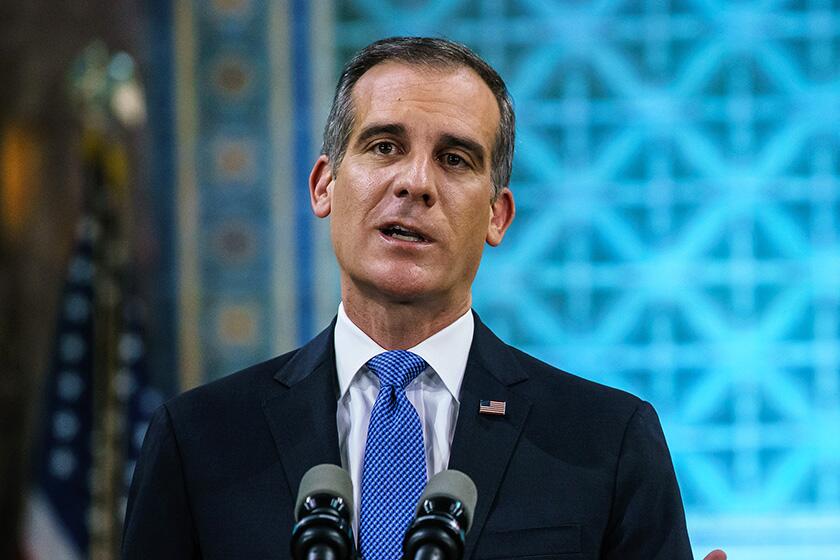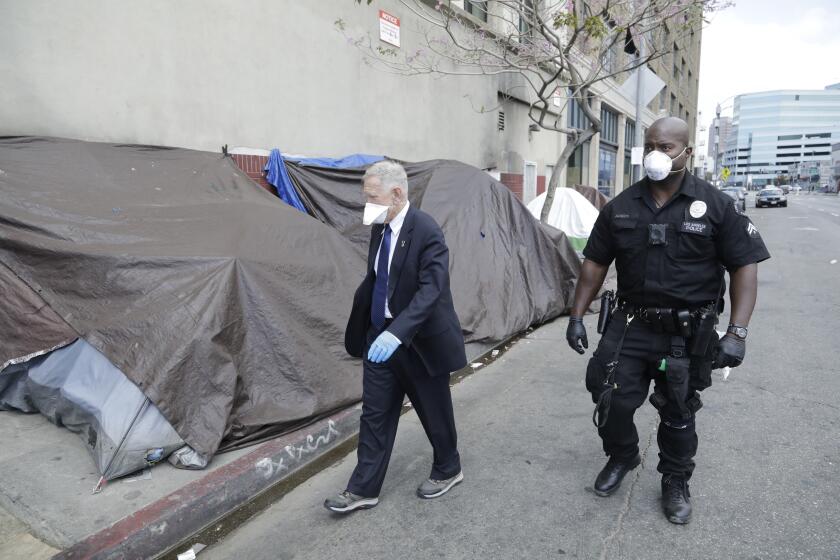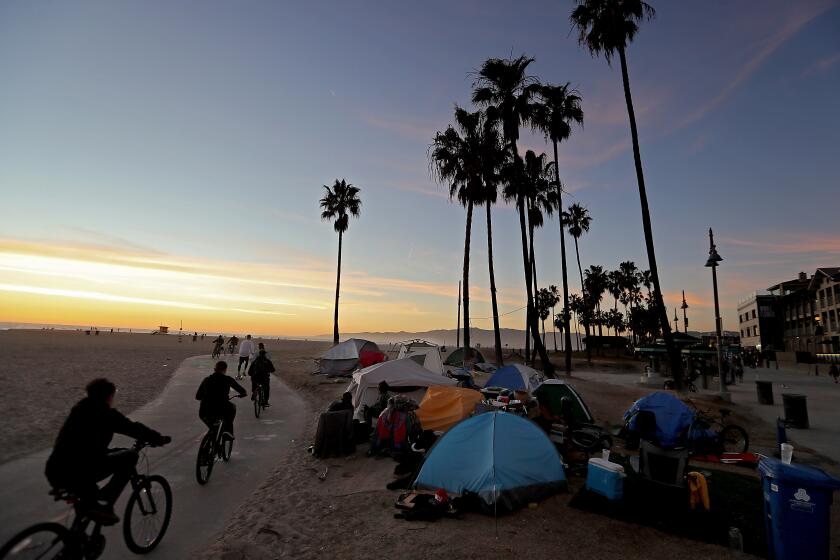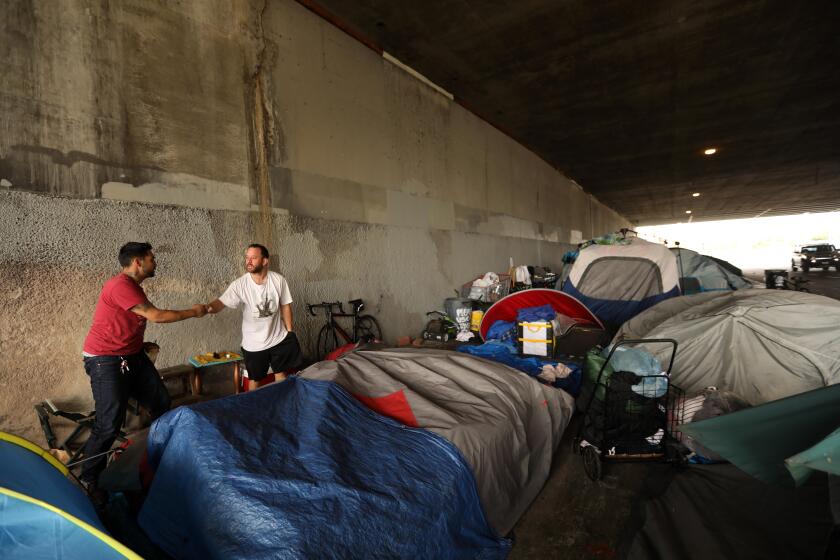L.A. plans nearly $1 billion in spending to address homelessness under Garcetti plan
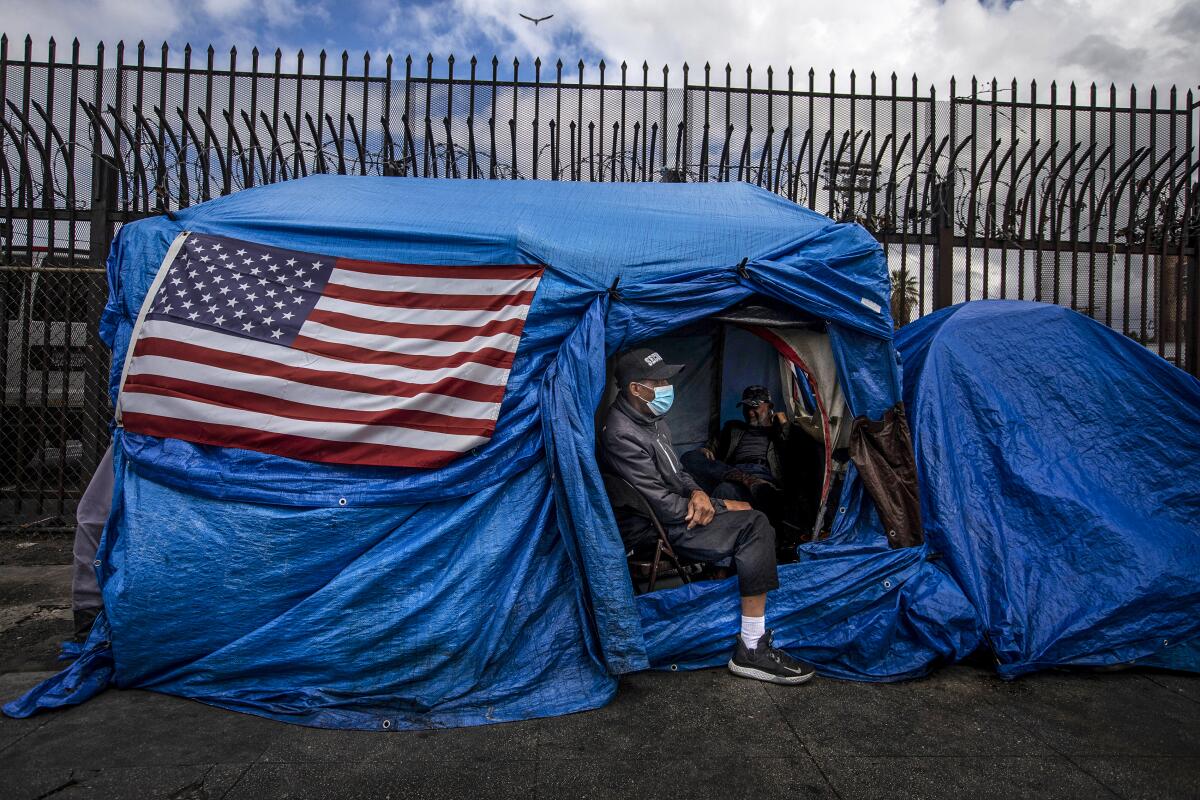
- Share via
Mayor Eric Garcetti is planning to spend nearly $1 billion to combat homelessness in the coming budget year, tapping huge new sources of state and federal aid and finally ramping up construction of homes for the unhoused.
Garcetti’s spending proposal, which will be discussed during his State of the City address on Monday, reflects the growing pressure he and others at City Hall are under to make significant headway on a crisis that has left tens of thousands of people living in squalor in streets, parks and beaches. Cities across the U.S. are relying on a similar playbook, using COVID-19 recovery funds to attack a problem that has confounded politicians for decades.
The mayor intends to propose $791 million in the upcoming budget year for initiatives to help homeless residents, increase cleanups around shelters and expand programs aimed at keeping housed Angelenos from slipping into homelessness themselves, mayoral aides said. On top of that, he expects to roll over more than $160 million that had been allocated for homelessness programs in the current year but has not yet been spent.
The spending plan represents a nearly sevenfold increase from the mayor’s budget five years ago, when he and other city leaders began acknowledging that much more money would be needed to address the crisis. If approved by the City Council, it would be the most that any Los Angeles mayor has allocated for homeless initiatives in a single year, said Matt Szabo, a deputy chief of staff in Garcetti’s office.
For Garcetti, “homelessness is the most critical issue that the city faces outside of COVID recovery,” Szabo said.
Mayor Eric Garcetti’s $24-million Basic Income Guaranteed program, which will be included in his city budget to be released Tuesday, would provide $1,000 a month to 2,000 Los Angeles families for a year.
Garcetti’s spending proposal reflects in part the city’s dramatically improved financial outlook. The mayor and council, who had been contemplating widespread employee layoffs a few months ago, are now deciding how to spend $1.35 billion in federal recovery funds.
The mayor’s proposed budget, set for release Tuesday, also comes at a moment of heightened frustration over the city’s handling of the issue among residents, business owners and anti-poverty activists.
The crisis now touches every neighborhood, with tents and other structures lining sidewalks, alleys, freeways, storm drains and even landscaped medians. In downtown Los Angeles, residents and business owners recently asked a federal judge to order the city and county to offer some form of shelter within 90 days to every homeless person on skid row.
In Echo Park, Garcetti and other city leaders have drawn fierce criticism over their decision to clear a massive encampment at Echo Park Lake. And on the Westside, residents have voiced alarm at a proposal to consider beach parking lots as spots for temporary homeless facilities.
Council members are discussing a settlement in a federal lawsuit that would entail thousands of new shelter beds and enforcement of anti-camping laws.
David Card, chairman of the Pacific Palisades Community Council, said the citywide homelessness problem is “awful” and just keeps growing.
“In the neighboring community of Venice, they’ve always had homelessness, but it’s just gotten so much worse,” he said. “And in Brentwood, people are very upset about the homeless tents on San Vicente.”
Garcetti intends to use nearly $100 million from President Biden’s rescue package for homelessness initiatives, Szabo said. In addition, Los Angeles is joining other cities and counties in tapping hundreds of millions in state funds for construction of shelters, tiny homes and the conversion of entire buildings into homeless housing.
Still, the single biggest source of additional spending in Garcetti’s proposal is expected to come from Proposition HHH, the much criticized $1.2-billion homeless housing bond approved by voters in 2016. The city’s HHH projects have been beset by rising costs and mired in delays. But in the coming budget year, $362 million will go toward the construction or development of 5,600 units, double the amount allocated for the current year.
The proposals reflect the shift that has taken place at City Hall since last year, when Angelenos filled the streets to protest police brutality and racial inequality.
Dr. Colette Auerswald, a UC Berkeley professor and an expert on youth homelessness, said she is encouraged by the mayor’s spending plan. Although the numbers are big, such financial outlays can be a bargain in the long run if they reduce the number of people on the streets, who end up costing taxpayers in other ways.
“Spending a billion dollars in a year on this issue probably starts to approach what needs to be done — assuming that that is being spent well,” she said.
Tommy Newman, senior director at United Way of Greater Los Angeles, echoed that idea, saying L.A. has long needed to spend more.
“If we had consistently invested at this proposed level over the past decades, there would not be tens of thousands of people sleeping outside every night, full stop,” he said.
Whether the city will succeed in spending all the money earmarked for homelessness in the coming year is unclear. Garcetti’s homeless programs have repeatedly faced delays or fallen short of their initial promise.
L.A. is far from the only city to ramp up spending on programs for the unhoused. Cities across California are trying tent cities, villages of tiny homes, conversions of hotels and motels, and other programs. Despite all that, homelessness, by some estimates, has continued to grow in many locations during the pandemic, adding urgency to the response.
Last week, Bay Area officials announced an ambitious plan, spanning nine counties, for reducing homelessness by 75% over the next three years.
San Francisco is looking at spending more than $560 million on homelessness next year, up from $242 million six years ago. And Sacramento has spent more than $110 million to address the problem over the last two years, compared with less than $2 million in 2015, said Mary Lynne Vellinga, spokeswoman for Sacramento Mayor Darrell Steinberg.
Garcetti’s spending plan represents enormous growth from 2016, when he proposed $138 million in funding for homeless programs. That same year, voters approved HHH, a property tax hike that pays for permanent housing with programs such as mental health or substance abuse counseling.
The COVID-19 pandemic has exacerbated the issue of homelessness in Southern California. We share images reminiscent of the Great Depression.
In April 2020, one month into the COVID-19 shutdowns, Garcetti proposed a budget with $385 million to address homelessness, not including expenditures at the LAPD. The city received an influx of state and federal aid months later, much of it from the Trump-era CARES Act, pushing the amount available much higher.
Garcetti’s budget team now projects that spending on homelessness could reach $800 million during the current budget year, which ends June 30. Still, that figure and several others remain fluid.
Spending for the current fiscal year is still underway. Furthermore, Garcetti’s proposal for next year’s homelessness spending does not include key initiatives to help needy families.
For example, the mayor plans to propose a $24-million pilot program to provide a “universal basic income,” building on an initiative already envisioned for parts of South Los Angeles. That program is not in the mayor’s list of proposals for keeping people from slipping into homelessness, Garcetti aides said.
The proposed budget includes an expansion of Project Roomkey, which has allowed the city to rent hotel rooms for homeless people during the pandemic. Six new hotels will be opened with a combined 523 rooms, bringing the total to 1,450, said Deputy Mayor Jose “Che” Ramirez.
Although federal funding for Project Roomkey is available only through September, city officials have asked the Biden administration to continue the program for a year or two longer, Ramirez said.
An additional $35 million will go to homelessness prevention, including eviction defense, while $20 million will go toward the construction and restoration of low-income housing in the city.
Szabo said next year’s budget also includes $56.6 million to clean up homeless encampments and expand storage facilities for homeless individuals’ possessions, up from $37.6 million. The cleanups have been criticized by homeless advocates, who say they too often are done without notice and often result in homeless people losing critical possessions.
Kenneth Mejia, an activist on housing and homeless issues, welcomed the idea of finding more money to help people get off the streets. But he argued that encampment cleanups do more harm than good for the unhoused — and should receive fewer dollars, not more.
Garcetti, he said, could have more of an impact by shifting large sums of money out of the Los Angeles Police Department and into homeless services.
“Lots of the police calls are dealing and relating to homelessness,” said Mejia, who is running for city controller. “So why not just go for the root causes, instead of spending more on symptoms?”
The $1 billion the mayor is spending should be directed toward permanently housing people.
Aides to the mayor believe even more state and federal aid will arrive in the coming months, pushing homelessness spending for the coming year well past $1 billion. The Biden infrastructure bill could yield more funds for affordable housing and rental assistance, they said, and the state budget will probably free up even more money for the purchase of motels and hotels.
Times staff writers Dakota Smith and Emily Alpert Reyes contributed to this report.
More to Read
Sign up for Essential California
The most important California stories and recommendations in your inbox every morning.
You may occasionally receive promotional content from the Los Angeles Times.
